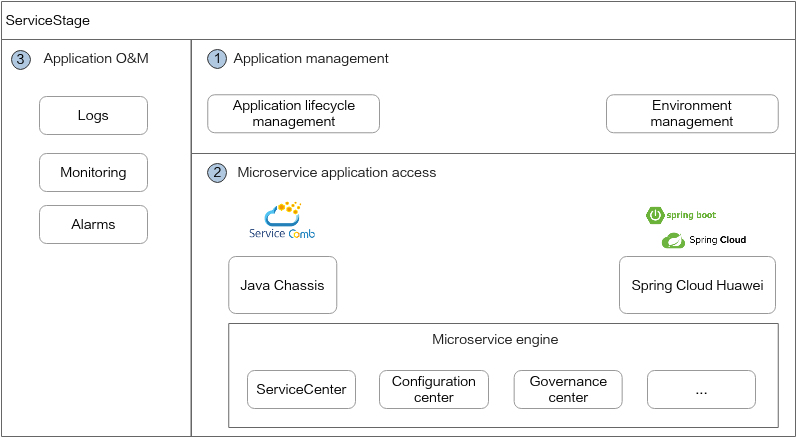What Is ServiceStage?
ServiceStage is an application management and O&M platform that lets you deploy, roll out, monitor, and maintain applications all in one place. It supports technology stacks such as Java, Node.js, Docker, and Tomcat, and supports microservice applications such as Apache ServiceComb Java Chassis (Java chassis) and Spring Cloud, making it easier to migrate enterprise applications to the cloud.
ServiceStage provides the following capabilities:
- Application management: application lifecycle management and environment management.
- Microservice application access: Java chassis, and Spring Cloud. Furthermore, ServiceStage works with CSE to implement service registration and discovery, configuration management, and service governance. .
- AOM: supports application O&M through logs, monitoring, and alarms.

Application Management
- Application lifecycle management
After an application is developed, it can be hosted on ServiceStage, which provides you with complete application lifecycle management:
- Application creation by using the source code, and software packages (JAR)
- Entire process management from application creation to logout, covering application creation, deployment, start, upgrade, rollback, scaling, stop, and deletion.
- Environment management
An environment is a collection of compute, network, and middleware resources used for deploying and running an application component. ServiceStage combines the compute resources (such as CCE clusters), network resources (such as ELB instances and EIPs), and middleware (such as DCS instances, RDS instances, and CSE engines) into an environment, such as a development environment, testing environment, pre-production environment, or production environment.
The resources within an environment can be networked together. Managing resources and deploying services by environment simplifies O&M.
Microservice Application Access
- Supports the native ServiceComb microservice framework.
Microservices developed by using the ServiceComb framework can be seamlessly connected to microservice engines.
The microservice engine uses Apache ServiceComb Service Center, which is a RESTful-style, high-availability, and stateless service registry and discovery center and provides microservice discovery and management. Service providers can register their instance information with the registry and discovery center for users to discover and use. For details about Apache ServiceComb Service Center, see the following:
- Compatible with mainstream microservice open-source frameworks.
Provides a simple access mode for microservices developed by using Spring Cloud. You only need to modify the dependencies and configurations to access microservice engines and use the unified governance policies.
- Provides microservice governance.
After an application developed using the microservice framework is managed on ServiceStage, the microservice will be registered with the service registry and discovery center after the application instance starts. You can govern microservices by referring to "Microservice Governance" in the User Guide.
Application O&M
- Multi-dimensional metrics monitoring for application components, helping you understand the running status of online applications.
- GUI-based log query and search, helping you quickly locate faults.
Feedback
Was this page helpful?
Provide feedbackThank you very much for your feedback. We will continue working to improve the documentation.See the reply and handling status in My Cloud VOC.
For any further questions, feel free to contact us through the chatbot.
Chatbot





